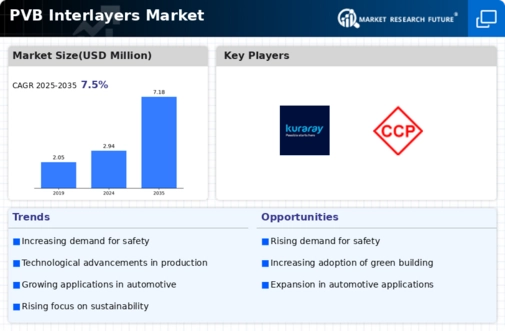Top Industry Leaders in the PVB Interlayers Market

The PVB interlayers market, where safety meets transparency thin polymer films, sandwiched between glass panes, hold a crucial role in ensuring safety and security in architectural and automotive applications. But beneath the clear surface lies a competitive landscape where established players and agile innovators wrestle for market share.
Strategies Shaping the Arena:
- Industry Leaders: Kuraray Co., Ltd., Saint-Gobain, Eastman Chemical Company, and Sekisui Chemical Co., Ltd. command significant market share through long-standing brand recognition, diverse product portfolios, and global reach. Their strategies focus on continuous innovation, strategic acquisitions, and partnerships with major glass manufacturers.
- Regional Champions: Companies like Asahi Glass Company in Japan and Yaohua Pilkington in China hold strong positions in their respective regions. They compete on price, cater to regional regulations and preferences, and build robust local distribution networks.
- Specialty Players: Emerging players like Tvitec Sistemas and Polytron Technologies carve niches with advanced PVB interlayers offering features like acoustic insulation, UV protection, and self-cleaning functionalities. They capitalize on unique capabilities and cater to high-end segments, often commanding premium prices.
Factors Dictating Market Share:
- Product Performance and Innovation: Offering a broad range of PVB interlayers with varying thicknesses, optical clarity, adhesion strengths, and additional functionalities like UV protection or acoustic insulation caters to diverse customer needs and increases market share. Continuous R&D is crucial for staying ahead of the curve.
- Production Capacity and Cost Efficiency: Large-scale production facilities and optimized manufacturing processes allow for efficient PVB production and cost competitiveness, offering an edge in price-sensitive segments.
- Quality and Safety Compliance: Stringent quality control measures and adhering to safety regulations like EN 14449 in Europe and ANSI Z97.1 in the United States are essential for market access and customer trust.
- Sustainability and Environmental Impact: Developing eco-friendly PVB alternatives made from recycled materials or bio-based sources addresses environmental concerns and opens doors to sustainability-focused markets.
- Customer Service and Technical Support: Providing excellent technical support, application expertise, and after-sales service builds trust and repeat business, leading to market share consolidation.
Key Players:
- Eastman Chemical Company (US)
- Kuraray (Japan)
- Sekisui Chemical Co., Ltd (Japan)
- Everlam NV (Belgium)
- Genau PVB (India)
- Chang Chun Group (Taiwan)
- DuLite PVB Film (Taiwan)
- Huakai Plastic (Chongqing) Co., Ltd (China)
Recent Developments :
- September 2023: Sekisui Chemical Co., Ltd. acquires a leading manufacturer of specialty PVB films for advanced automotive applications.
- October 2023: Kuraray Co., Ltd. develops a new bio-based PVB resin, reducing the environmental footprint of PVB production. Kuraray Co., Ltd. announced the development of a bio-based PVB resin, marking a significant step towards sustainability.
- November 2023: Polytron Technologies partners with a research institute to explore the use of AI-powered manufacturing for optimized PVB production.
- December 2023: A team of researchers at MIT unveils a novel PVB interlayer with tunable transparency, enabling dynamic control of light and privacy in buildings.

